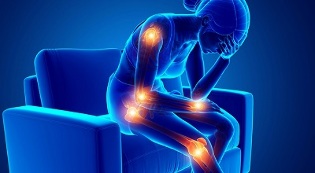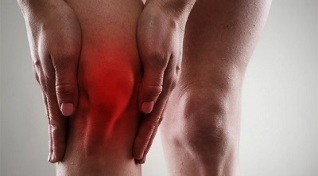The tissues of healthy joints are made up of cells that are able to repair damage. Bones, cartilage, synovium and other substances can be harmful to health. Dead, damaged cells accumulate in certain tissues. There are no split abilities that prevent renewal. They are difficult to remove, which is a major problem in the restoration of joint health.
Under any physical force, strong mechanical stress can damage cells and cause their death. It is difficult for an already diseased joint to carry a load. It is very difficult to heal. To prevent or eliminate the disease, it is necessary to understand the defense mechanisms of articular tissues and cells. Arthritis, osteoarthritis, polyarthritis and other diseases are different in the area of joint damage. Let's take a closer look at the difference between arthritis and osteoarthritis.
The first cause of the disease
The joint is protected by a neuromuscular cushion. Thanks to the muscle contraction control system, the shock effect does not occur or is reduced. The nervous system provides smooth movements, load distribution. At rest, the muscles also stimulate microvibrations and lead to the release of lubricating oil and the removal of dead cells.
Impaired neuromuscular amortization occurs due to poor transmission of nerve pathways. For example, fatigue weakens the joint's defenses. Dead cells begin to accumulate before they have time to be discarded. The result is inflammation. Weakening of protection accelerates the degradation not only of the joints, but also of the spine.
A number of factors increase joint disease, starting with bruises, bruises, overload, and hypothermia. Arthritis occurs - an inflammatory process. If it is not possible to treat for months, the deformities begin - osteoarthritis.
What is arthritis: causes, symptoms
Causes can occur:
- Wrong food.
- Bad habits: alcohol, smoking.
- Systemic hypothermia.
- Injuries.
- Excessive stress on the joints.
- Consequences of past diseases and infections.

The disease is characterized by the following symptoms:
- Swelling in the joints, painful sensations, increased sensitivity, limited mobility (ie synovitis).
- Acute pain during movement and rest.
- Morning stiffness due to swelling at night. Operates one hour after start.
In addition to the listed symptoms, symptoms of inflammation may appear: weakness, sweating, chills, fever. Some have headaches and weight loss. Sometimes co-morbidities occur: the heart and lungs are affected.
What is osteoarthritis: causes and symptoms
Symptoms of osteoarthritis as a result of progressive arthritis often appear only after 40 years.
The disease is characterized by the following manifestations:
- Pain does not appear in a calm state, but during tension. Unpleasant sensations occur in the hip or knee joint when walking, using stairs or exercising. This initial pain may disappear with more movement. There is a strong painful sensation during bending, bending, accompanied by a crisis.
- Pain when starting to move after rest is caused by the deposition of detritus on the friction surfaces - the products of cartilage and bone destruction. After 15 minutes, the sensation may stop, because this sediment is thrown out.
- Dull pain at night is caused by a blockage in a vein.
Inflammation often occurs with osteoarthritis. Swelling is observed along with painful sensations (as in arthritis). If you have symptoms of both diseases, you are diagnosed with osteoarthritis.
Prolonged course of osteoarthritis can lead to limited mobility. Degenerative changes (contractures) begin in the muscles and tendons, and then deform. This condition is diagnosed as deformed osteoarthritis or osteoarthritis.
Distinguish the stages of the disease determined by X-ray images as a result of computed tomography:

- 1 degree- slight changes in cartilage and bone. Painful swelling subsides after a period of rest and occurs with moderate intensity.
- 2 degrees- destruction of cartilage, growth in the form of osteophytes at the edges of bone tissue. Narrowing of the joint space accompanied by constant pain. Swelling also stabilizes.
- 3, 4 degrees- extensive destruction of cartilage and bone. Swelling does not pass, ligaments and muscles do not work properly and deformation occurs. Load reading is a concern in the joint.
The risk factors for osteoarthritis are:
- Lack of movement.
- Overweight.
- Age factors.
- Low blood and lymph flow, infections caused by stagnation.
In any case, tissues do not have time to recover during the process of joint destruction.
Differences between arthritis and osteoarthritis
Both arthritis and osteoarthritis are becoming more common diseases. Diseases that affect the joints have similar names. The differences are in the nature of the adverse changes that occur during the onset and development of symptoms. Pain in arthritis is a result of tissue inflammation. Synovium is affected, blood supply, lymph is disrupted, the disease affects the nerve endings. The joint stops eating properly and cannot produce lubricant. Cartilage suffers.
The disease can be observed not only in adults but also in children (juvenile form). The lesion affects any joint, even small joints such as the fingers, and can cover several of them (polyarthritis).
Osteoarthritis occurs as a result of long-term arthritis. Cartilage and all joints do not receive nourishment from synovial fluid (lubricant) for a long time. Often there is an exacerbation in the form of inflammation. First, cartilage is destroyed as a bone covering, and in later stages, bone tissue may suffer. Cartilage areas do not have time to regenerate, it softens. Pain appears due to damage to the sliding surfaces in the joint.
This disease occurs after 40 years. By affecting large joints (hip - coxarthrosis or knee - gonarthrosis), it can cause disability, making a person disabled. Fingers (osteoarthritis) and feet are less affected. The disease can also be observed in the temporomandibular, elbow, shoulder and other joints.
Thus, osteoarthritis is a consequence of the development of arthritis symptoms, taking a devastating stage.
Prevention and treatment

In arthritis, malnutrition of cartilage and joints should not be aggravated by inflammation. The cause must be eliminated at the same time as the return of foci to anti-inflammatory drugs. If you do not take action, the disease can turn into osteoarthritis. If you suspect both diseases, you need to make a correct diagnosis, for which you should consult a specialist. This is done by a rheumatologist, orthopedic traumatologist and surgeon. You are required to visit the clinic. Some diagnostic centers provide such services to an arthrologist.
An important principle of healing is to stop destroying while stimulating salvation. This approach will help prevent irreversible changes. To do this, the tissues are cleaned of damaged cells caused by injury or infection. Increase blood and lymph flow, nutrition. Insufficient nerve connections from the spine often lead to the development of arthritis and osteoarthritis. When symptoms appear, the load on the joint should be reduced.
Drug treatment includes:
- Non-steroidal anti-inflammatory and analgesic drugs.
- Hormonal preparations in the form of injections.
- Cytostatics reduce the number of antibodies that kill cells.
- Chondroprotectors restore cartilage and synovial fluid.
The lymph flow that cleanses the tissues of the affected cells is not stimulated. However, there is a method of vibroacoustic therapy that consists of exposure to microvibration from vibroacoustic therapy (between 30 and 20, 000 Hz). Both are used in physiotherapy and exercise. In the 3rd and 4th stages of the disease, prostheses are used.
Result
Painful sensations and dysfunction in the joints cause many serious problems. But a bigger problem is the destruction of the inflammatory processes that occur in them, restricting movement, causing deformities and disabilities. Proper diagnosis is important for timely treatment. In addition to understanding the causes of these problems, you need to be aware of the ways in which they can be overcome.























